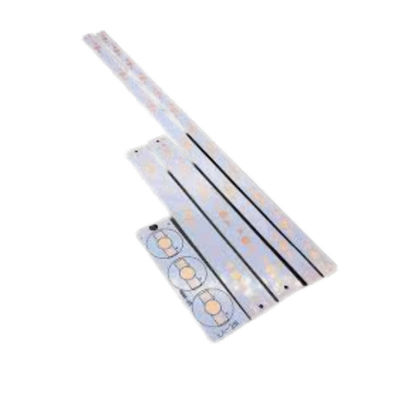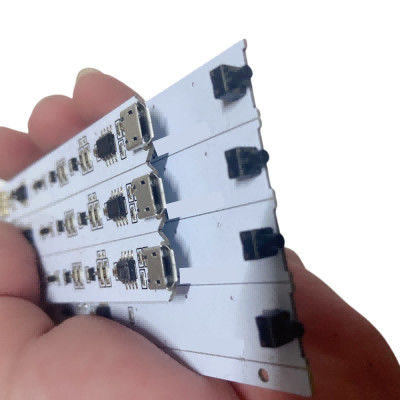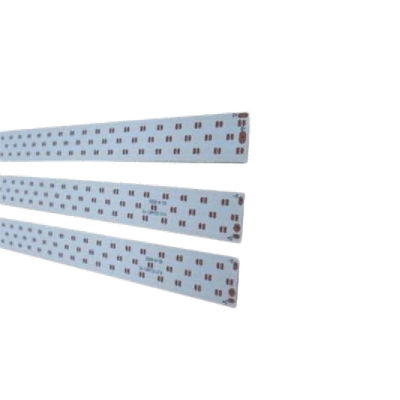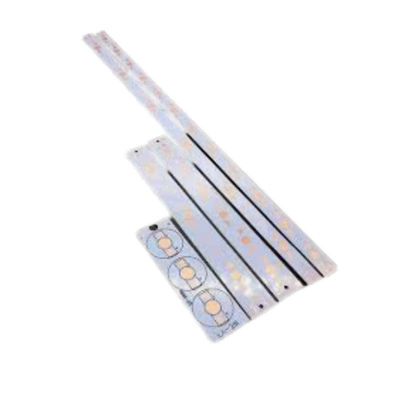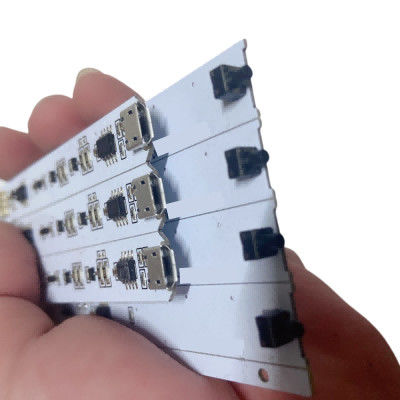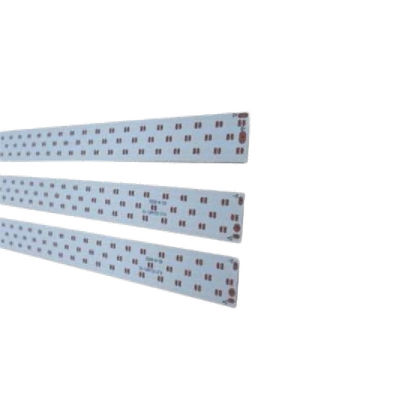Immersion Gold Aluminium PCB Board For LED Bulb Lamp 0.5oz 1oz Copper Thick
| Place of Origin | Shenzhen |
|---|---|
| Brand Name | YScircuit |
| Certification | ISO9001,UL,REACH, RoHS |
| Model Number | YS-LE-0007 |
| Minimum Order Quantity | 1 piece |
| Price | 0.03-6$/piece |
| Packaging Details | Foam cotton + carton + strap |
| Delivery Time | 2-8 days |
| Payment Terms | T/T,PayPal, Alibaba pay |
| Supply Ability | 251,000 square meter/year |

Contact me for free samples and coupons.
Whatsapp:0086 18588475571
Wechat: 0086 18588475571
Skype: sales10@aixton.com
If you have any concern, we provide 24-hour online help.
x| Material | Aluminum | Size | 5-45cm |
|---|---|---|---|
| Process | Immersion Gold | Surface Finishing | HASL/HASL-LF/ENIG |
| Board Thickness | 1.6mm | Copper Thickness | 1oz,0.5oz-2oz |
| Application | Bulb Lamp | Min. Line Spacing | 4mil |
| High Light | 1oz Aluminium PCB Board For LED,0.5oz Aluminium PCB Board For LED,Immersion Gold Aluminium LED PCB |
||
LED PCB Board OEM Aluminum Lighting Print Circuit Boards For Bulb Lamp
What is Aluminum PCB?
An aluminum PCB has a similar layout to Normal PCB. It has a layer or layers of copper, solder mask and silkscreen layered over it.
Instead of having a fiberglass or plastic substrate, though, an aluminum circuit board has a metal substrate.
This base mainly contains a combination of aluminum.
The metal core can consist entirely of metal or have a combination of fiberglass and aluminum.
Aluminum PCBs typically are single sided, but can be double sided as well.
Mulilayer Aluminum PCBs are highly difficult to manufacture.
What Do You Need to Know About LED PCBs
LED PCBs are typically thin for efficiency and heat dissipation, which allows for higher performance of the assemblies.
Performance of Aluminum PCB
1. Thermal Dissipation
Common PCB substrates, such as FR4, CEM3 are poor conductors of thermal.
If the heat of electronic equipments cannot be distributed in time, it will result in high temperature failure of electronic components.
Aluminum substrates can solve this thermal dissipation problem.
2. Thermal Expansion
Aluminum substrate PCB can effectively solve the thermal dissipation problem, so that the thermal expansion and contraction problem of components on printed circuit boards with different substances can be alleviated, which improves the durability and reliability of whole machine and electronic equipments.
In particular, aluminum substrate can solve the SMT (surface mount technology) thermal expansion and contraction problems.
3. Dimensional Stability
Aluminum substrate printed circuit board has apparently higher stability than the insulating material of the printed circuit board.
When heated from 30 ° C to 140 ~ 150 ° C, the dimensional change of aluminum substrate is only 2.5 ~ 3.0%.
4. Other Performance
Aluminum substrate printed circuit board has shielding effect, and can alternative brittle ceramic substrate.
Aluminum substrate also helps to improve the heat resistance and physical properties and reduce production costs and labor.
| Layer | 1-24 |
| Material | Aluminum core (Domestic 1060), Copper core, FR4 covering |
| Thickness (Finished Board) | 0.8 mm-5.0 mm |
| Max. Board Size | 610 mm*610 mm |
| Copper weight (finished) | 0.5 oz-4.0 oz |
| Surface Finish | Hot air solder leveling (HASL) Lead-free HASL: RoHS compliant Electroless nickel/immersion gold (ENIG): RoHS compliant |
| Min. Tracing/Spacing | 4 mil/4 mil |
| Min. diameter of drill | 8mil |
| Min. Annular ring | 4mil |
| Soldermask Color | Green, red, black, yellow, white, blue, green matt, black matt |
| Silkscreen Legend Color | White, Black, Yellow |
| Countersink holes | Yes |
| Screw holes | Yes |
| layer/m² | S<1㎡ | S<3㎡ | S<6㎡ | S<10㎡ | S<13㎡ | S<16㎡ | S<20㎡ | S<30㎡ | S<40㎡ | S<50㎡ | S<65㎡ | S<85㎡ | S<100㎡ |
| 1L | 4wds | 6wds | 7wds | 7wds | 9wds | 9wds | 10wds | 10wds | 10wds | 12wds | 14wds | 15wds | 16wds |
| 2L | 4wds | 6wds | 9wds | 9wds | 11wds | 12wds | 13wds | 13wds | 15wds | 15wds | 15wds | 15wds | 18wds |
| 4L | 6wds | 8wds | 12wds | 12wds | 14wds | 14wds | 14wds | 14wds | 15wds | 20wds | 25wds | 25wds | 28wds |
| 6L | 7wds | 9wds | 13wds | 13wds | 17wds | 18wds | 20wds | 22wds | 24wds | 25wds | 26wds | 28wds | 30wds |
| 8L | 9wds | 12wds | 15wds | 18wds | 20wds | 20wds | 22wds | 24wds | 26wds | 27wds | 28wds | 30wds | 30wds |
| 10L | 10wds | 13wds | 17wds | 18wds | 20wds | 20wds | 22wds | 24wds | 26wds | 27wds | 28wds | 30wds | 30wds |
| 12L | 10wds | 15wds | 17wds | 18wds | 20wds | 20wds | 22wds | 24wds | 26wds | 27wds | 28wds | 30wds | 30wds |
| 14L | 10wds | 16wds | 17wds | 18wds | 20wds | 20wds | 22wds | 24wds | 26wds | 27wds | 28wds | 30wds | 30wds |
| 16L | 10wds | 16wds | 17wds | 18wds | 20wds | 20wds | 22wds | 24wds | 26wds | 27wds | 28wds | 30wds | 30wds |
![]()
![]()
![]()
![]()
![]()
WHAT IS AN ALUMINUM PCB?
A PCB generally consists of three layers. A conductive copper layer at the top, a dielectric layer in between, and a layer of a substrate at the bottom. Standard PCBs have a substrate layer made of fiberglass, ceramic, polymers, or any other non-metal core. An ample amount of PCBs uses FR-4 as the substrate.
Aluminum PCBs use an Aluminum substrate. Instead of standard FR-4 as the substrate material.
Circuit Copper Layer
This layer transmits signals over the entire PCB board.
The movement of charged particles generates heat.
This heat is transferred to the Aluminum substrate. Which dissipates it efficiently.
Insulating Layer
This layer is also known as the dielectric layer.
It is made of materials that are poor conductors of electricity.
It absorbs the heat generated in the above layer. And transfer it to the Aluminum substrate below it.
Substrate
The substrate acts as a foundation for the PCB.
It firmly holds the components above it. By changing the characteristics of the substrate, the performance of PCB varies.
For example, a rigid substrate provides strength and durability to the PCB board.
While a flexible substrate opens up more design options.
The aluminum substrate is used in power electronics-based applications where high thermal dissipation is required.
Due to its good thermal conductivity, it keeps heat away from vital electronic components. Thus ensuring minimal circuit damage.
ALUMINUM PCBs MANUFACTURED AT YScircuit
YScircuit is one of the finest manufacturers of Aluminum PCBs.
To increase the overall performance of the product, they provide a thermal clad layer to the Aluminum PCB.
It dissipates heat in a highly efficient manner. For high power and tight tolerance based applications Aluminum Backed PCB is the perfect choice among project makers.
Considering parameters like the coefficient of thermal expansion, thermal conductivity, strength, hardness, weight, and cost. Aluminum plate is an ideal choice for your project. You can modify your PCB substrate. PCBWay offers different Aluminum plates like 6061, 5052, 1060, and many more.
ADVANTAGES OF ALUMINUM PCB
1. The heat dissipation capacity of Aluminum PCBs is far better than standard PCBs.
2. Aluminum PCBs provide more strength and durability. As compared to ceramic and fiberglass-based PCBs.
3. It seems ironic, but aluminum-based PCBs are lighter. As compared to standard PCBs.
4. Thermal expansion and contraction of PCB components get reduce by using Aluminum PCB.
5. PCBs made of Aluminum are environmentally friendly. It is non-toxic and recyclable. It does not create any harmful impacts on our planet.
6. The assembling process of Aluminum PCB is easy than that of standard PCB.
APPLICATIONS
1. They are used in Power supply devices like switching regulators, DC/AC converter, SW regulator.
2. In power modules, they are used in inverters, solid-state relays, and rectifier bridges.
3. In automobiles, they are used in an electronic regulator, ignition, power supply controller, etc.
4. They are the perfect choice for amplifiers. Balanced amplifier, audio amplifier, power amplifier, operational amplifier, high-frequency amplifier.
5. They are used in the transmitting and filtering circuit.
6. They are used to make the CPU board. And power supply of computers.
7. Electric motors require a high current for their operation. In industries, motor driver circuits use Aluminum PCB.
8. These are a popular choice for LED applications due to their energy-saving capability.




